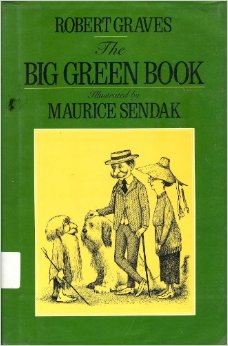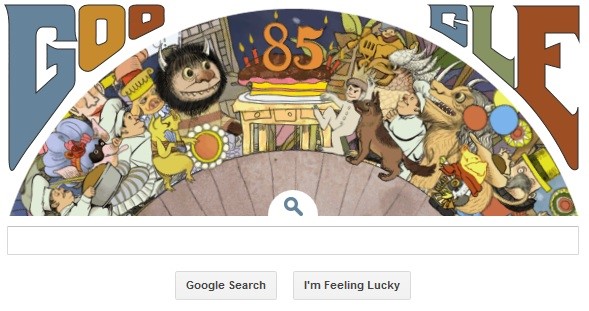
One year before Maurice Sendak wrote Where the Wild Things Are, he contributed the illustrations to a remarkable book. Robert Graves was 67 years old, and had already written the popular novel I, Claudius (as well as a memoir of his experiences in World War I). But as both a poet and a scholar, Graves decided to write a children’s book about the magic of reading. The Big Green Book describes a little boy named Jack, who discovers the very magical book in his uncle’s attic.
This story is surprisingly edgy – even before Sendak contributes his dark, angular drawings. “Jack’s father and mother were dead, and the uncle and aunt were not very nice to him,” Graves writes – setting up Jack’s desire to find a sanctuary. The boy scowls at the couple’s enormous sheepdog, and objects to long walks in the field. But Sendak finally draws the boy finding a moment to himself – alone in a room at the top of flight of stairs…
It was better than a story book. “The big green book was full of magic spells. It told him how to make himself as old or young as he liked…and how to make birds or animals do just as he liked, and how to disappear.” There were “spells” for winning card games, and lessons on speed-reading. And Sendak draws a row of six pictures capturing the boy’s delighted reactions – standing in open-mouthed surprise, jumping with delight, reading intently, and confidently following the instructions…
67-year-old Graves writes how Jack turned himself into an old man with a long beard. (His aunt and uncle don’t recognize him – and when they start to approach him, Jack makes himself disappear – and then reappear.) I wondered if Graves was using the character to deliver his own wry observation about life itself. “Yes: a little boy was here only a minute ago… Now he’s disappeared.”
The boy plays cards against his aunt and uncle – and he wins every time. Soon they owe Jack “about a hundred thousand dollars.” Sendak’s drawing captures the despair on the couple’s face perfectly. By the end they’re on their knees begging for a chance to win it back. And instead they lose their house to the boy – along with their enormous sheepdog.
Before the book is over, the boy plays more pranks on his guardians that are sometimes even nastier. His uncle’s fingernails grow through his hand. (“‘Ow!’ said the uncle.”) Their sheepdog is chased away by a belligerent rabbit. But best of all, Jack surveys the house he now owns, from top to bottom – and then turns himself back into a little boy.
And then he revisits his aunt and uncle to tease them about their losses.



